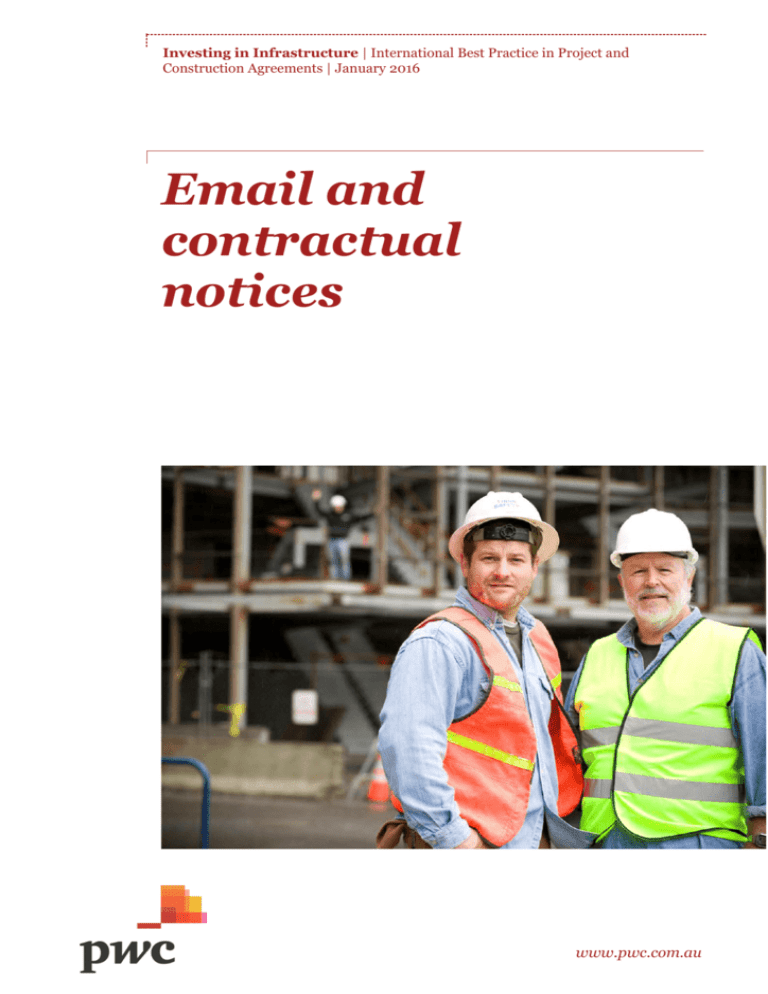
Investing in Infrastructure | International Best Practice in Project and
Construction Agreements | January 2016
Email and
contractual
notices
www.pwc.com.au
Email and contractual notices
Introduction
It is common practice for contracts to include a clause which specifies the requirements for the delivery and
receipt of contractual notices. An example of a standard notices clause is as follows:
Unless expressly stated otherwise in this agreement, all notices, certificates, consents, approvals, waivers and
other communications in connection with this agreement must be:
(a)
in writing
(b)
signed
(c)
left at the address, sent by prepaid ordinary post, sent by fax, or given in any other way permitted
by law.
They take effect from the time they are received unless a later time is specified.
The rapid development of the use of email has led to uncertainty regarding the legal status of contractual
notices sent by email. This update considers the current legal position under English, Hong Kong and
Australian law in relation to email notices.
Legislation
Email notices have unique limitations – both legal and technological. The uncertainty in this area and the rapid
speed of technological development means there is little case law on the status of email notices. For this reason,
legislation has been passed in many jurisdictions to deal specifically with the particular issues arising from
notices sent by email.
The United Nations Commission on International Trade Law (UNCITL) published its Model Law on Electronic
Commerce in 1996. This established a guiding set of minimalist rules, which many countries have now adapted
to their needs.
The relevant legislation is the Electronic Communications Act 2000 in the United Kingdom, the Electronic
Transactions Ordinance (Cap 553) 2000 in Hong Kong and the Electronic Transactions Act 1999 in Australia.
The purpose of each statute is to place electronic messages on par with other methods of communication, so
that actions will not be invalidated or discriminated against merely because they were conducted electronically.
Each statutory regime is facilitative, rather than restrictive.
Importantly, each of the statutes based on the guidelines of the UNCITL Model Law are ”opt-in” statutes. That
is, they do not apply unless the parties agree to conduct transactions electronically. However, consent does not
have to be express – it can be implied from the conduct of the parties. 1
1
Brogden v Metropolitan Railway Co (1877) 2 App Cas 666; Malthouse v Adelaide Milk Supply Co-operative Ltd [1922] SASR 572.
PwC
3
Email and contractual notices
Legal issues
Several legal issues which arise in relation to notices sent by email are set out below.
Is email ”writing”?
For a notice to be effective under the example standard clause, it must be in writing. At common law ”writing”
means any method of transcribing or reproducing the written word and may be ink, pencil or otherwise. The
question of whether email falls into this category is not within the scope of this update because under the new
legislation in England, Hong Kong and Australia, electronic messages are deemed to be ”writing”. 2
Electronic signatures
For a notice to be effective under the example standard clause, it must also be signed. As technology is
undergoing rapid change in the field of electronic signatures, and because all business needs differ, several
jurisdictions adopt the minimalist approach which dictates that the reliability of the electronic signature must
be appropriate given regard to the circumstances. This means that it will be up to the courts to determine on a
case-by-case basis whether the signature is valid.
For example, section 7 of the Electronic Communications Act 2000 (UK) utilises a broad definition. It states
that an electronic signature is:
so much of anything in electronic form as –
(a)
is incorporated into or otherwise logically associated with any electronic communication or
electronic data
(b)
purports to be so incorporated or associated for the purpose of being used in establishing the
authenticity of the communication or data, the integrity of the communication or data, or both.
Australia also follows this approach, stating that an electronic signature is valid if sent by means appropriate in
the circumstances, and for which the identity of the sender and their consent to the communication is verified. 3
Both the English and the Australian statutory regimes leave room for businesses to utilise the technology most
applicable to their needs, without placing an onerous standard for electronic signatures across the board. It is
also deliberately flexible to allow room for future technological developments.
As a comparison, section 2 of Hong Kong’s Electronic Transactions Ordinance is more definitive of what will
constitute an electronic signature, defining them as:
generated by the transformation of the electronic record using an asymmetric cryptosystem and a hash
function such that a person having the initial untransformed electronic record and the signer’s public key can
determine:
(c)
whether the transformation was generated using the private key that corresponds to the signer’s
public key
(d)
whether the initial electronic record has been altered since the transformation was generated.
This definition may prove to be restrictive upon a party’s choice of technology in the future.
2
Electronic Transactions Act 1999 (Cth) s 9; Electronic Communications Act 2000 (UK) c 7, s 8; Electronic Transactions Ordinance (Hong Kong)
cap 553, s5.
3
Electronic Transactions Act 1999 (Cth) s 10(b).
PwC
4
Email and contractual notices
Ongoing obligations
If parties to a contract make express provision to allow for email notices, it is likely that the courts will hold
them to a fairly high standard if the context of the situation and the conduct of the parties showed a reliance on
this form of communication.
For example, Canadian common law has interpreted the agreement between the parties as to the method of
communication strictly, holding the parties to their intention under the contract. In Kanitz v Rogers Cable Inc, 4
the Ontario Superior Court of Justice found that the plaintiffs had an obligation to continually check the
defendant’s web site (upon which the user agreement between the parties was updated from time to time),
because the user agreement expressly allowed for this eventuality. Further, the court stated that parties who
wish to conduct their business electronically must also bear the risks of doing so. 5
Silence on the use of email
If a contract is silent on the issue of notices by email, the question is then: Does a notice sent by email satisfy
the requirements for a valid notice set out in the contract? This question was considered most recently in Kavia
Holdings Pty Ltd v Suntrack Holdings Pty Ltd. 6 Where the provisions of the contract in question required that
all notices:
• "shall be in writing"
• "may be given to or served upon a party"
• "may be signed on behalf of the party giving the same by a director, manager, secretary or acting secretary of
such party".
The court considered that the relevant notice, which was sent by email, satisfied these requirements because the
mandatory requirement as to writing was satisfied and the two permissive requirements were also met by
transmission of the email and inclusion of the sender's name and email address, noting that:
Any other conclusion would produce a capricious and commercially inconvenient result that might have
wide-reaching and unintended consequences in modern day trade and commerce. 7
This decision is consistent with Metacorp Australia Pty Ltd v Andeco Construction Group Pty Ltd 8 where the
Victorian Supreme Court also considered permissive notice clauses and deemed the service of a notice by
email valid.
Technological limitations
At present, there are several technological drawbacks inherent in electronic communication which a contracting
party should be aware of before it agrees to be bound by email notices, including: 9
• email address may be obtained without proof of identity
• emails may be sent from another person’s computer without their permission
• it is not possible for the sender to ascertain with any confidence whether the recipient has read the message,
even with delivery or read receipt notification
4
(2002) 21 BLR (3d) 104.
5
Ibid, [32] (Nordheimer J).
6
[2011] NSWSC 716
7
Kavia Holdings Pty Ltd v Suntrack Holdings Pty Ltd [2011] NSWSC 716.
8
(2010) 30 VR 141.
9
See also I Briggs and S Brumpton, 'Embrace E-construction with care!' (2001) 13(4) Australian Construction Law Bulletin 25, 29.
PwC
5
Email and contractual notices
• changes may be made to the email prior to or after receipt without detection
• there are confidentiality concerns if access is gained to the email or to the server by an unintended party
• unencrypted email is relatively insecure, meaning that email recipients must be wary of the identity of the
sender in the absence of a digital signature.
These limitations may assist a party to deny that it had received the relevant notice. If email message
confirmations are not sufficiently reliable, a party binding itself to a deemed delivery provision bears the risk
that it may be taken to have received a message that it has not in fact received.
Proving email notices in court
Under the Civil Evidence Act 1995 (UK), electronic evidence may be admitted in court subject to proof as to the
reliability of that evidence, 10 particularly of the operation of the system used to record and store the electronic
evidence.10 This circumvents the practical difficulties of proving the contents and service of an email notice in
court. Section 9 of Hong Kong’s Electronic Transactions Ordinance recognises the admissibility of electronic
records in Hong Kong courts. In Australia, several statutory provisions overcome the common law evidentiary
rules against admitting electronic records as evidence. 11
Despite these statutory provisions for admission of electronic evidence, parties may need to call experts to give
evidence on the operation of their IT systems, and in particular that the data so received was adequately
managed and secure.
Conclusion
Given the importance of contractual notices and the issues raised in this update, we recommend that as a
general rule email should not be used for the delivery of contractual notices (as opposed to normal day-to-day
communications).
However, this position should be reviewed on a case-by-case basis, taking into account the circumstances of the
parties and the continual development in email security and reliability.
10 Civil Evidence Act 1995 (UK) c 39, ss 8-9. Section 8 states that copies of a document are admissible; section 9 provides that documents which form part of
the records of a business are automatically admissible.
11 Uniform Evidence Act 1995 (Cth) ss 48, 69, 146, 147; Electronic Transactions Act 1999 (Cth) s 11.
PwC
6
www.pwc.com.au
© 2016 PricewaterhouseCoopers. All rights reserved.
PwC refers to the Australian member firm, and may sometimes refer to the PwC network.
Each member firm is a separate legal entity. Please see www.pwc.com/structure for further details.
At PwC Australia our purpose is to build trust in society and solve important problems. We’re a
network of firms in 157 countries with more than 208,000 people who are committed to delivering
quality in assurance, advisory and tax services. Find out more and tell us what matters to you by
visiting us at www.pwc.com.au
Liability limited by a scheme approved under Professional Standards Legislation.






